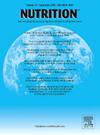肥胖和骨关节炎患者身体成分参数与生活质量的关系
IF 3.2
3区 医学
Q2 NUTRITION & DIETETICS
引用次数: 0
摘要
背景与目的本研究的目的是评估生物阻抗测定(BIA)测定的身体成分与肥胖和慢性骨关节炎患者的生活质量(QoL)和功能能力之间的关系。方法采用描述性横断面研究,纳入467例肥胖和慢性骨关节炎患者(女性350例,男性117例)。记录年龄、性别、体重指数(BMI)、生活质量(以总分百分比表示)和BIA参数(肌肉质量指数(MMI)、脂肪质量指数(FMI)、相位角(PA)、BMI调整后的PA、电抗(Xc)和电阻(RZ))。根据WOMAC总分将患者分为4个四分位数。结果患者平均年龄为60.12(10.87)岁,女性占74.9%。平均BMI为40.14 (5.39)kg/m2(男:39.74 (5.52)vs.女:40.27 (5.35)kg/m2, P = 0.36)。WOMAC总评分为49.12(22.15)%(男46.40 (21.58)% vs.女51.10 (22.25)%,P <;0.05);刚度评分为47.73%(男:44.35(30.36)%,女:48.85 (28.45)%,P = 0.15);疼痛为52.26(25.34)%(男:50.73(32.68)比女:52.77 (22.39)%,P = 0.45);功能容量为49.07(23.38)%(男:45.48(23.18)比50.27 (23.35)%,P = 0.06)。MMI、bmi调整PA与WOMAC功能容量评分呈负相关(r = -0.16, P <;男女均为0.05)。结论在肥胖和慢性骨关节炎患者中,生物阻抗测定的肌肉质量可能与WOMAC试验测定的生活质量有关。BMI调节的相位角的减小与生活质量的轻微下降有关。本文章由计算机程序翻译,如有差异,请以英文原文为准。
Relationship between body composition parameters and quality of life in patients with obesity and osteoarthritis
Background and aims
The aim of this study was to evaluate the relationship between body composition determined by bioimpedanciometry (BIA) with quality of life (QoL) and functional capacity in patients with obesity and chronic osteoarthritis.
Methods
The design was a descriptive cross-sectional study in a sample of 467 patients (350 women and 117 men) with obesity and chronic osteoarthritis. Age, sex, body mass index (BMI), QoL WOMAC test (expressed as a percentage from total score) and BIA parameters (muscle mass index (MMI), fat mass index (FMI), phase angle (PA), BMI-adjusted PA, reactance (Xc) and resistance (RZ)) were recorded. Patients were divided according to total WOMAC score in four quartiles.
Results
The mean age of the patients was 60.12 (10.87) years and 74.9% of the patients were women. The mean BMI was 40.14 (5.39) kg/m2 (M: 39.74 (5.52) vs. W: 40.27 (5.35) kg/m2, P = 0.36). Total WOMAC scores were 49.12 (22.15) % (M: 46.40 (21.58) vs. W: 51.10 (22.25)%, P < 0.05); for stiffness, the score was 47.73% (M: 44.35 (30.36) vs. W: 48.85 (28.45)%, P = 0.15); for pain, it was 52.26 (25.34)% (M: 50.73 (32.68) vs. W: 52.77 (22.39)%, P = 0.45); and for functional capacity, it was 49.07 (23.38)% (M: 45.48 (23.18) vs. W: 50.27 (23.35)%, P = 0.06). MMI and BMI-adjusted PA were negatively correlated with WOMAC functional capacity score (r = –0.16, P < 0.05 for both sexes).
Conclusions
In patients with obesity and chronic osteoarthritis, muscle mass determined by bioimpedanciometry could have a relationship with quality of life determined by the WOMAC test. The decrease in the phase angle adjusted by BMI was related to a slightly decrease in the quality of life.
求助全文
通过发布文献求助,成功后即可免费获取论文全文。
去求助
来源期刊

Nutrition
医学-营养学
CiteScore
7.80
自引率
2.30%
发文量
300
审稿时长
60 days
期刊介绍:
Nutrition has an open access mirror journal Nutrition: X, sharing the same aims and scope, editorial team, submission system and rigorous peer review.
Founded by Michael M. Meguid in the early 1980''s, Nutrition presents advances in nutrition research and science, informs its readers on new and advancing technologies and data in clinical nutrition practice, encourages the application of outcomes research and meta-analyses to problems in patient-related nutrition; and seeks to help clarify and set the research, policy and practice agenda for nutrition science to enhance human well-being in the years ahead.
 求助内容:
求助内容: 应助结果提醒方式:
应助结果提醒方式:


